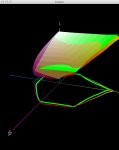Ian wrote: "Technically you could increase density, build new profiles, separate with these profiles and get a bigger gamut."
G: Yes. You could also use the same separations but run at higher SIDs to achieve the extra gamut.
Ian wrote: "Any pressman who has gone down this path will tell you that this will not alleviate the known problems encountered in impact printing that are aggravated with high densities if you don't fix fundamental problems inherent in current separation technology. These issues include ink offset, drying problems, excessive back trapping, poor chemical trapping and ink emulsification."
G: I'm not quite sure about your meaning here. In my experience, a press in nominal working condition using standard inks and conventional separations can reliable increase their SIDs by about 20-25 points without issues. I.e. K: 1.95/2.00, C: 1.6, M: 1.75, Y: 1.25
What SIDs are you advising/using?
Ian wrote: "Not to mention the question of how do you determine the optimal higher SID?"
G: By doing a press test. This blog post explains the basics:
Quality In Print: Printing at DMaxx - part 1 of 5
Ian wrote: "We have been involved in projects that have tried this and simply pushing density flat out failed."
G: And I have been involved with many projects where using standard separation techniques, pushing SIDs and using a dot gain compensation curve has been very successful. As just one example, we did this at the Heidelberg demo facilities in Kennesaw GA in the early days of CtP to show some of the potential that CtP offered beyond simply eliminating film.
Your are correct about the complexities of separating for the Hexachrome process. Are you suggesting that ICE'd separations at higher SIDs equals (or exceeds) the Hexachrome gamut? I also agree that using high pigment load inks can also be problematic. If you can achieve a bigger gamut with standard inks and without adding press units - that would be the first choice.
Ian wrote: "ICE intelligently sets SID not for gamut gain, but to optimize squeeze and pressure to improve inkflow and printability on a given stock. The separation then distributes ink in such a way as to focus colored ink where the image needs color. Even using similar densities in areas that use similar builds, an ICE sep will demonstrate increased visual gamut as more colored ink will flow the color needy image areas without being stolen by the rest of the form."
G: I cannot understand what you you are trying to say. Maybe with more information...but I guess that would be divulging your "secret sauce."
I hope meddington does a proper evaluation. At the very least, what, I would like to see:
1) Test document with standard separations run to normal SIDs
2) Same document as 1 but run to higher SIDs (say 20-25 points higher) but using plate curves to normalize dot gain.
3) Same document run to same normal densities as 1 but with ICE'd separations
4) Same document as 3 using ICE'd separations but printed at higher SIDs (whatever Ian and Co. recommends)
of course, all 4 should be profiled so that their gamuts can be better compared.
Also, because the objective targets like process color tone patches, step wedges, and gradients don't go through a separation process they can provide baseline info on what the separation technique is adding to the process.
best, gordon p
my print blog here:
Quality In Print current topic: Printshop Evils














